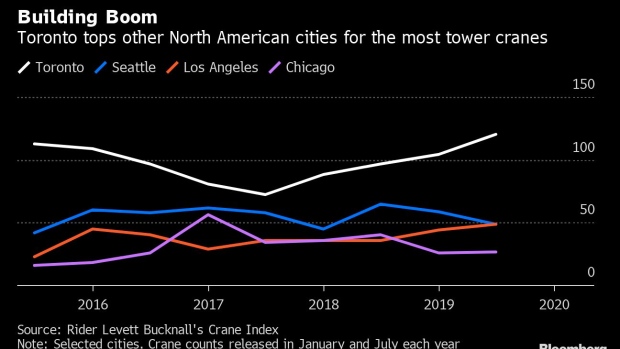Feb 21, 2020
Construction ‘Rock Stars’ Rule in North America’s Top Crane City
, Bloomberg News

(Bloomberg) -- As office workers pour into downtown Toronto from their morning commutes, Mathew Tiburcio is already at his seat -- in a glass box hovering some 50 stories above the crowded streets.
The 35-year-old is one of a brotherhood of crane operators helping to shape the skyline of Canada’s largest city during a historic development boom. Toronto is dotted with more cranes than any other North American city, and Tiburcio has bragging rights for operating the tallest one.
It gives him a killer view of Lake Ontario from a perch 860 feet (262 meters) up, even higher than the condo towers and office buildings nearby. But he’s not getting paid to enjoy the scenery. He’s doing one of the most critical tasks in construction.
“It can be very stressful, especially on a big job like this,” Tiburcio said on a break from helping to build CIBC Square, the future headquarters of Canadian Imperial Bank of Commerce. “It’s what gets me up in the morning. Every day is something new and every day is a new challenge.”
Crane operators have been called the “rock stars” of construction, willing to work for hours in isolation at dizzying heights, manipulating machinery to hoist steel beams and other heavy materials around congested building sites. Demand for the operators is soaring in and around Toronto, where about 120 cranes rise from projects across the metropolitan area.
It’s part of a decade-long building boom in North America’s fastest-growing city that shows no signs of wavering. A surge of immigration has fueled the market for housing, and a proliferation of condo towers. New office developments downtown, already home to Canada’s biggest financial firms, are drawing tech companies including Google, Shopify Inc. and Microsoft Corp., which is moving its Canadian headquarters from a Toronto suburb to CIBC Square.
Read More: Toronto Building Boom Set to Lift City’s Skyscraper Ranks
This winter workday is typical for Tiburcio. He rises in the wee hours for the 50-kilometer (31-mile) drive from his suburban home to reach the job site by 5 a.m. He’s one of about 740 workers building the twin-skyscraper project being developed by Canada’s Ivanhoe Cambridge and Houston-based Hines.
Tiburcio spends 20 minutes ascending to the operational heart of a Comedil CTL 630 tower crane. He starts by riding a lift up the side of an unfinished building to an open 46th floor. He then crosses a metal walkway to the crane’s white steel tower, and scales a series of ladders to reach the cab.
After doing his inspections, he gets busy. He’ll spend the next eight hours or so in a cramped enclosure, on a padded seat he personalized with a black cover and a yellow, orange and red flame design.
His hands embrace a pair of joysticks: One lifts the boom and swings the crane left and right, while the other controls the hoist. Paperback-sized video screens guide his efforts. To his upper left is a monochrome screen showing the crane’s radius, load weight and hook height. Motorola radios dangle overhead, providing a link to workers below.
“You’ve got many trades that need the crane and you’re doing your best to help everybody out and give everybody a lift,” said Tiburcio, a crane operator for 11 years. “Everybody needs to work, everybody has their job to do.”
At 49 floors, this is the tallest building Tiburcio has worked on, and he calls it the highlight of his career.
But the job hasn’t been easy. When he started on the project a couple of years ago, he worked 70 to 80 hours a week while he and his wife faced the demands of being first-time parents. Things eased up when relief operators were brought in, giving Tiburcio the chance to spend more time with his son, who’s now a toddler and thinks Dad has the coolest job.
“He already knows all about tower cranes,” Tiburcio said.
The Toronto native knows about fatherly influence: He followed his own dad into construction, spending three years as a laborer. When he was ready for a change, Tiburcio’s boss at the time told him about the demand for tower crane operators. He’s had steady work since making the transition, and makes a six-figure salary.
As he mans his controls, Tiburcio takes time to scan his 360-degree view and tally the cranes around him. He counts 40 -- assurance that work won’t dry up when this current job is done.
“There are plenty more projects coming up.”
To contact the reporter on this story: Doug Alexander in Toronto at dalexander3@bloomberg.net
To contact the editors responsible for this story: Michael J. Moore at mmoore55@bloomberg.net, Christine Maurus, Craig Giammona
©2020 Bloomberg L.P.





